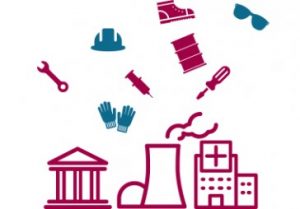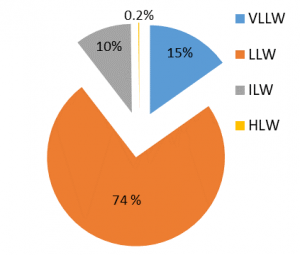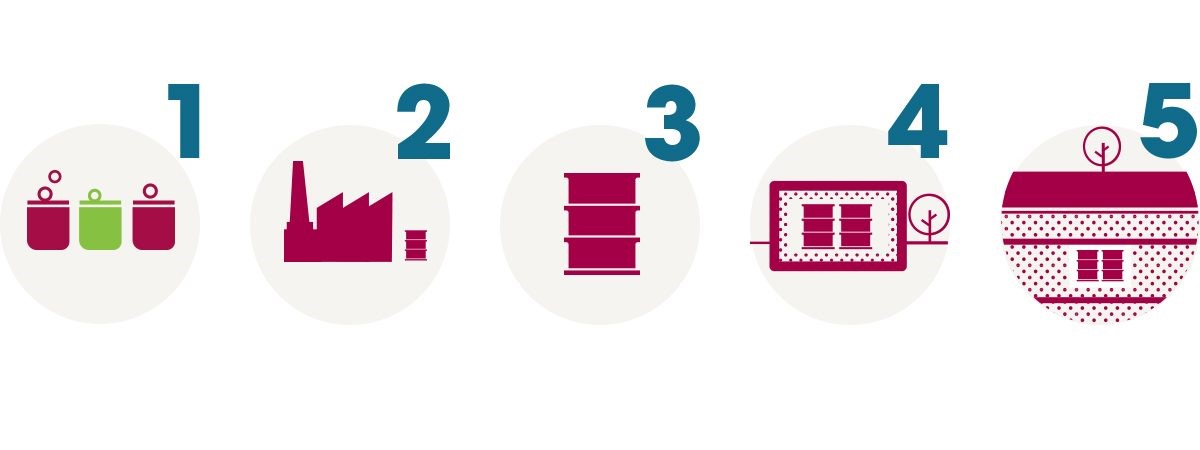Radioactive waste includes all types of waste that are radioactive. They need to be treated and stored and handled with the necessary security. There are different kind of waste types, with different levels of radioactivity, and they are all differently treated.

Figure 1 Different sources of nuclear waste – educational institutes, power plants and hospitals1
All countries have radioactive waste, even those not running Nuclear Power Plants (NPP). Nuclear waste has a number of origins, the biggest part comes from NPPs. This includes fuel elements and other materials that are radioactive and need to be disposed of, such as filters, protective clothing, exchange materials etc.
The medical sector also creates nuclear waste e.g. in diagnostics or cancer treatment (needles, clothing, etc). Other waste comes from the agriculture (sterilization through irradiation) and the industry in general (e.g. radioactive sources are needed to check welds, or the moisture in asphalt).
 There are different types of radioactive waste – each type requiring adapted measures to guarantee a safe storage short term or long term. Waste is classified depending on their level of radioactivity and half lives.
There are different types of radioactive waste – each type requiring adapted measures to guarantee a safe storage short term or long term. Waste is classified depending on their level of radioactivity and half lives.
Regarding its time – radioactive waste is classified as short lived if the half-life of the waste is shorter than 30 years, and long lived radioactive waste if the half-life of the waste is longer than 30 years.
After 300 years (approx. 10 half-lives), the levels of the short-lived radioactive waste are negligible, so that they equal the natural level of radioactivity. This waste can then be treated as ordinary waste.
Looking at the radioactivity level of radioactive waste and the half-life together, radioactive waste can be categorized as follows:
- Very Low Level Waste (VLLW): waste that does not need a high level of containment and isolation and, therefore, is suitable for disposal in near surface landfill type facilities with limited regulatory control.
- Low Level Waste (LLW): waste that is above clearance levels, but with limited amounts of long-lived radionuclides. Such waste requires robust isolation and containment for periods of up to a few hundred years and is suitable for disposal in engineered near surface facilities. This class covers a very broad range of waste. LLW may include short-lived radionuclides at higher levels of activity concentration, and also long-lived radionuclides, but only at relatively low levels of activity concentration.
- Intermediate Level Waste (ILW): waste that, because of its content, particularly of long-lived radionuclides, requires a greater degree of containment and isolation than that provided by near surface disposal. However, ILW needs no provision, or only limited provision, for heat dissipation during its storage and disposal. ILW may contain long-lived radionuclides, in particular, alpha emitting radionuclides that will not decay to a level of activity concentration acceptable for near surface disposal during the time for which institutional controls can be relied upon. Therefore, waste in this class requires disposal at greater depths, of the order of tens of metres to a few hundred metres.
- High Level Waste (HLW): waste with levels of activity concentration high enough to generate significant quantities of heat by the radioactive decay process or waste with large amounts of long-lived radionuclides that need to be considered in the design of a disposal facility for such waste. Disposal in deep, stable geological formations usually several hundred metres or more below the surface is the generally recognized option for disposal of HLW2.

Figure 3 The management steps of radioactive waste1
Nuclear waste management can be illustrated by the example of the Belgian waste management. It consists of 5 steps (Figure 4):
- Prevention, limitation and sorting: The producer of the waste ( NPP, research center, hospital etc) has to identify and sort the waste streams.
- Volume reduction: The volume of the waste is reduced if possible. For solid waste by compaction, for burnable waste by incineration.
- Stabilization and confinement: The compacted waste is confined into a barrel and ILW/HLW is immobilised, typically by cement or through vitrification.
- Storage: The barrels are stored safely in halls that protect the environment and the public from radiation exposure.
- Disposal: the waste is isolated until the levels of radioactivity are negligible.
Before going into disposal, radioactive waste needs to be stored. The storage type depends very much on the type of waste. Each European country has to nominate (in its National Program) an organization that takes care of the radioactive wastes. Depending on the country different approaches were chosen. Waste will always be treated in the safest way to ensure the protection of public and the environment.
As this type of waste does not contain any radioactive substances with long half-lives, it can be stored close to the surface (depending on the country). There must be protection barriers in place to ensure that the waste is isolated, and not remobilised.
Energy production and other nuclear applications create radioactive waste that is considered as high-level waste. At the moment, this waste is safely stored, but this is only a temporary solution. Most countries have agreed that a geological disposal facility is the best option to dispose of high level radioactive waste. This means isolating the waste at a depth of several hundred meters below earth in a stable matrix, surrounded by artificial barriers. Together, the natural and artificial barriers will guarantee long term safety. Sweden, Finland, France, Switzerland, the United States and South Korea are some of the countries where there are detailed plans to construct such facilities, and Finland has already started.

References
1 Forum Nucleaire Belge. (2019). What about our nuclear waste? Accessed 19/08/19 at: <https://www.forumnucleaire.be/theme/dechets-nucleaires/quen-est-il-de-nos-d%C3%A9chets-nucl%C3%A9aires>
2 European Commission. (2017). Inventory of radioactive waste and spent fuel present in the Community’s territory and the future prospects. Accessed 19/08/19 at: https://ec.europa.eu/energy/sites/ener/files/documents/staff_working_document_progress_of_implementation_of_council_directive_201170euratom_swd2017_161_final.pdf>